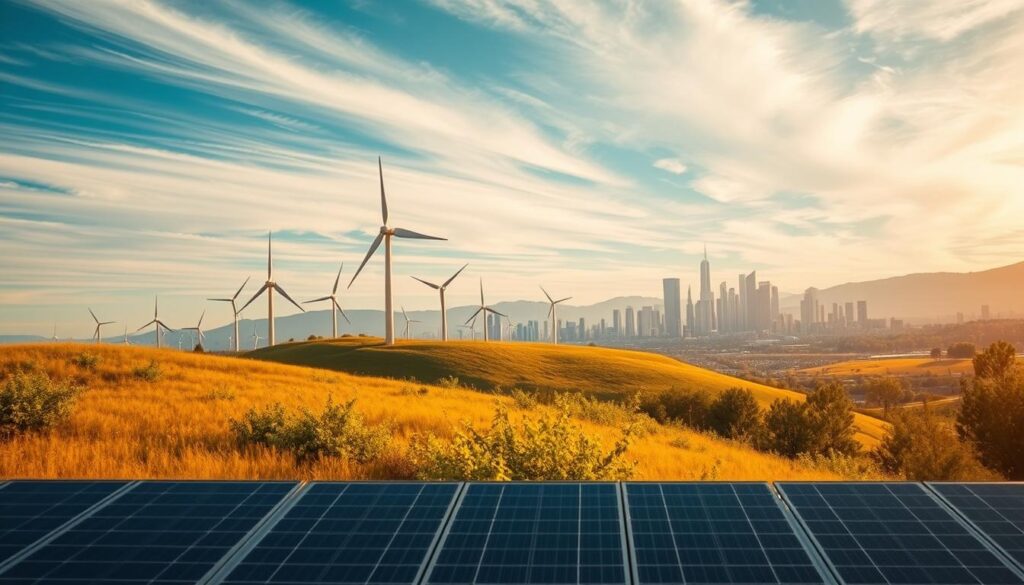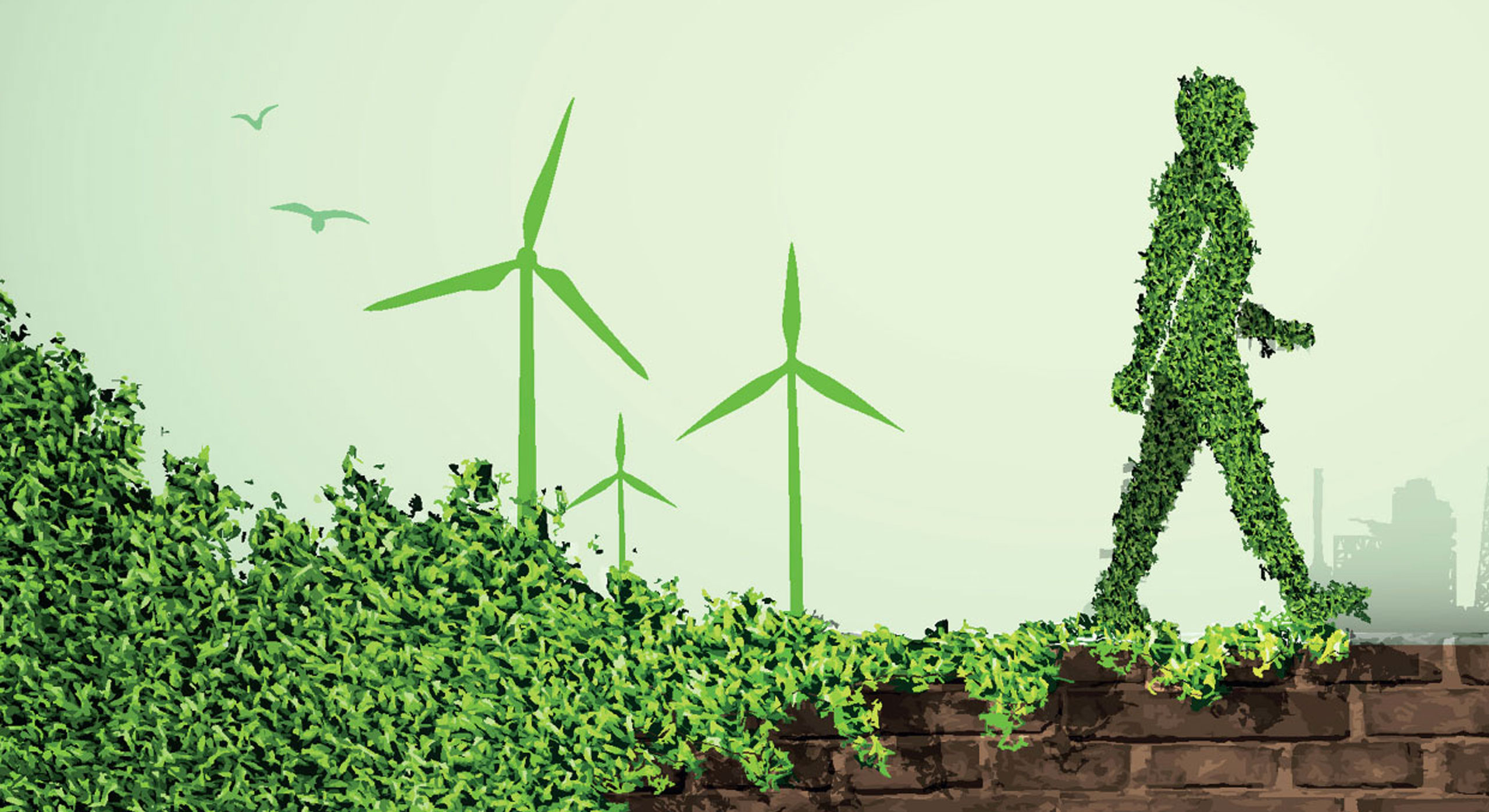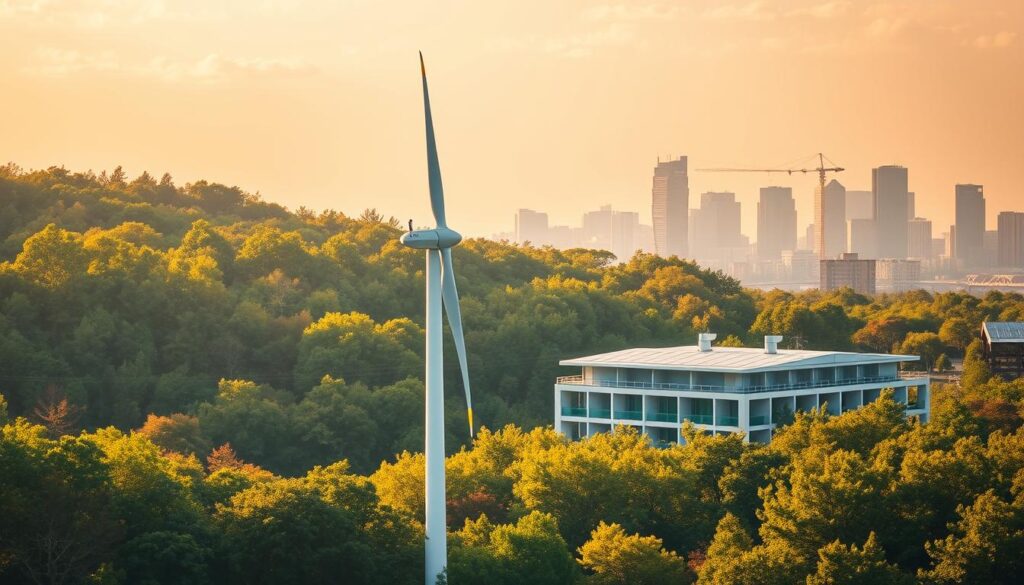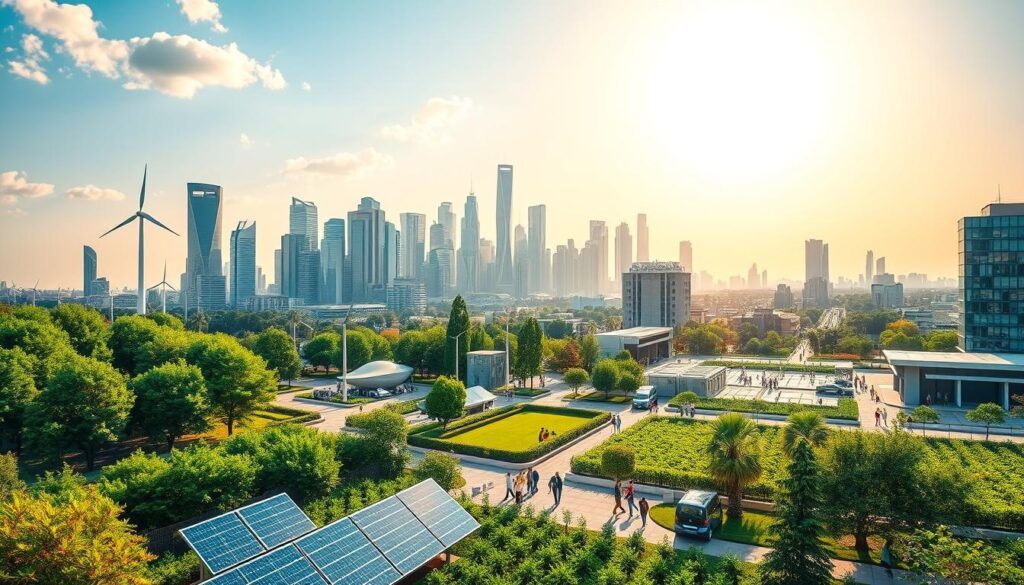
In today’s world, eco-friendly innovations are playing a crucial role in building a sustainable future. These advancements are helping us move away from fossil fuels and toward cleaner, more efficient solutions. From solar panels to wind turbines, renewable energy sources are transforming how we power our lives.

One of the most significant benefits of these innovations is the reduction in greenhouse gas emissions. By adopting cleaner energy practices, we can protect our planet and conserve natural resources. Governments worldwide are also stepping up, with policies like the Infrastructure Investment and Jobs Act driving progress in this field.

As we look ahead, the focus on renewable energy and energy efficiency will continue to grow. These changes are not just about protecting the environment—they’re about creating a better future for everyone. Let’s explore how these advancements are making a difference today.
Key Takeaways
- Eco-friendly innovations are reducing reliance on fossil fuels.
- Renewable energy sources like solar and wind power are leading the way.
- Government policies are supporting the growth of sustainable practices.
- Reductions in greenhouse gas emissions are a key benefit.
- Energy efficiency is improving through technological advancements.
Understanding Green Technology
Sustainable advancements are transforming how we approach energy, resources, and conservation. These innovations aim to reduce environmental harm while improving efficiency across industries. From renewable energy to waste management, the scope is vast and impactful.
Definition and Scope
Green technology refers to practices and tools designed to minimize negative environmental impacts. It spans sectors like energy, agriculture, and transportation, focusing on reducing emissions and conserving resources. For example, solar panels and wind turbines are key players in this space.
Companies are increasingly integrating these solutions into their ESG strategies. By adopting sustainable practices, they not only reduce their carbon footprint but also attract eco-conscious investors.
Environmental Impact and Benefits
One of the most significant benefits is water conservation. Smart irrigation systems and sustainable farming techniques help reduce waste and preserve this vital resource. Additionally, electric vehicles and alternative fuels are cutting down on fuel consumption and emissions.
Carbon reduction is another critical focus. Technologies like solar and wind power are leading the charge in lowering greenhouse gas emissions. These advancements are not just good for the planet—they also help companies save money and improve efficiency.
“The future of sustainability lies in innovative solutions that balance environmental and economic needs.”
By embracing these practices, businesses can optimize resource use, reduce costs, and build a reputation for environmental responsibility. The shift toward sustainable solutions is not just a trend—it’s a necessity for a better future.
The Evolution and History of Green Technology

From ancient irrigation systems to cutting-edge wind turbines, the history of eco-friendly solutions is rich and transformative. Over centuries, humanity has sought ways to balance progress with environmental preservation, leading to remarkable innovations and policy-driven changes.
Early Innovations and Industrial Shifts
The Industrial Revolution marked a turning point, highlighting the need for alternative energy sources and laying the groundwork for modern sustainability. Early efforts, like the first hydroelectric power plant in 1882, showcased the potential of renewable energy. Windmills, used for centuries, evolved into modern wind turbines, offering a cleaner alternative to fossil fuels.
Post-war recycling efforts also played a crucial role. Governments and organizations began implementing programs to manage waste more effectively, reducing environmental harm. These early steps set the stage for today’s advanced waste-to-energy systems.
Modern Developments and Policy Advances
The 1970s environmental movement, including Earth Day and the Clean Air Act, marked a significant shift in environmental preservation. The establishment of the EPA in 1970 further prioritized reducing emissions and promoting sustainable practices.
Modern advancements, like electric vehicles and smart grids, represent a leap from early innovations. Wind power has become a viable alternative to fossil fuels, with significant growth in the 1980s and 1990s. Policies like the Paris Agreement continue to drive global collaboration in achieving sustainability goals.
“The future of sustainability lies in innovative solutions that balance environmental and economic needs.”
By tracing this evolution, we can better understand how far we’ve come—and how much further we can go in building a sustainable future.
green technology in Action: Renewable Energy and Beyond
Renewable energy is reshaping how we power our world, offering cleaner and more efficient solutions. From solar panels to wind turbines, these innovations are transforming the energy sector and reducing our reliance on fossil fuels. The impact of these changes is already visible, with communities worldwide benefiting from cleaner air and lower energy costs.
Solar, Wind, and Beyond
Solar power is one of the fastest-growing renewable energy sources. The cost of solar photovoltaic modules has dropped by over 90% since 2010, making it an affordable solution for many regions. Wind energy is also gaining momentum, with the Global Wind Energy Council forecasting 680 GW of new capacity by 2030. These technologies are not only reducing carbon footprints but also creating jobs and driving economic growth.
Real-world examples of renewable energy projects highlight their potential. For instance, the Hornsea Project in the UK is the world’s largest offshore wind farm, powering over a million homes. Similarly, the Noor Solar Complex in Morocco is one of the largest solar installations, significantly reducing the region’s reliance on fossil fuels.
“The transition to renewable energy is not just about protecting the environment—it’s about creating a better future for everyone.”
Combating Climate Change
Renewable energy plays a crucial role in addressing climate change. By reducing greenhouse gas emissions, these technologies help stabilize global temperatures and improve air quality. The International Energy Agency projects that achieving net-zero emissions by 2050 could create up to 14 million jobs in clean energy and related sectors.
Looking ahead, the integration of renewable energy with smart grids and energy storage systems will enhance efficiency and reliability. This change is not just a trend—it’s a necessity for a sustainable future. As more communities and businesses adopt these solutions, the positive impact on our planet will continue to grow.
Challenges and Obstacles in Adopting Eco-Friendly Innovations
While the benefits of sustainable solutions are clear, the road to implementation is not without hurdles. From high initial investments to policy delays, several barriers slow down the adoption of eco-friendly innovations. Let’s explore these challenges in detail.
Infrastructure and Cost Barriers
One of the biggest challenges is the high upfront cost of eco-friendly solutions. For example, solar panels can range from $5,000 to $15,000, while electric vehicles start at $30,000 or more. These expenses make it difficult for many households and businesses to adopt these technologies.
Insufficient infrastructure also poses a significant problem. A lack of charging stations for electric vehicles and inadequate power grids for renewable energy sources hinder widespread adoption. Without proper support systems, even the most advanced products struggle to gain traction.
Policy Gaps and Supply Chain Issues
Policy and regulatory barriers create uncertainty for investors and innovators. Unclear rules and delays in approvals slow down progress in the industry. For instance, regulatory hurdles and lack of alignment across regions impede the development of sustainable solutions.
Supply chain challenges further complicate matters. Shortages of critical components, like transformers for clean energy integration, delay projects. These issues are exacerbated by global supply chain disruptions, making it harder to scale eco-friendly production.
“The transition to sustainable solutions requires not just innovation but also supportive policies and infrastructure.”
| Challenge | Impact | Potential Solutions |
|---|---|---|
| High Initial Costs | Limits accessibility for households and businesses | Subsidies, tax incentives, and financing options |
| Insufficient Infrastructure | Hinders adoption of electric vehicles and renewable energy | Investment in charging stations and grid upgrades |
| Policy Delays | Slows innovation and investment | Streamlined regulations and international collaboration |
| Supply Chain Issues | Delays project implementation | Diversified supply chains and local production |
Addressing these challenges requires collaboration between governments, industry leaders, and communities. By tackling these obstacles, we can pave the way for a more sustainable world.
Economic, Environmental, and Social Benefits of Green Innovations

From reducing costs to enhancing public health, sustainable innovations are making a tangible impact. These advancements are not just about protecting the planet—they also bring significant economic and social benefits. Let’s explore how these solutions are transforming industries and improving lives.
Financial Savings and Competitive Advantages
Adopting eco-friendly practices can lead to substantial financial savings for companies. Upgraded production processes and innovative technology selections help reduce costs and improve profitability. For example, energy-efficient systems lower utility bills, while waste reduction strategies cut operational expenses.
These innovations also enhance competitive advantages. Companies that prioritize sustainability often see improved market competitiveness and a stronger corporate image. This attracts eco-conscious consumers and investors, driving long-term growth.
Public Health and Community Well-Being
One of the most significant benefits of sustainable solutions is their ability to reduce pollution and harmful gas emissions. Technologies that capture carbon and other pollutants are improving air quality and reducing respiratory diseases. Cleaner air means healthier communities and fewer healthcare costs.
These advancements also promote social progress and improve living standards. By addressing environmental challenges in an innovative way, sustainable practices contribute to overall well-being. For instance, renewable energy projects create jobs and provide affordable power to underserved areas.
“Sustainable innovations are not just good for the planet—they’re good for people and businesses too.”
| Benefit | Impact | Example |
|---|---|---|
| Financial Savings | Reduced costs and improved profitability | Energy-efficient systems |
| Pollution Reduction | Cleaner air and fewer respiratory diseases | Carbon capture technologies |
| Community Well-Being | Improved health and living standards | Renewable energy projects |
By embracing these solutions, businesses and communities can achieve a healthier, more prosperous future. The benefits of sustainable innovations are clear—they’re a win-win for everyone.
How Investments Are Driving the Future of Sustainable Tech

Investments in sustainable solutions are reshaping industries and paving the way for a cleaner future. From renewable energy to smart infrastructure, funding is accelerating innovations that address pressing environmental issues. In 2023, global investment in clean energy reached $1.77 trillion, marking a 17% increase from the previous year.
Trends in Green Investments and Funding Opportunities
Venture capital and private equity firms are leading the charge, with companies like Tesla and Rivian attracting significant funding. Public markets are also seeing a surge in cleantech-related IPOs, reflecting growing investor confidence in this area. Renewable energy accounted for 90% of global power capacity expansions in 2021, highlighting the sector’s rapid growth.
Government policies and incentives are playing a crucial role in fostering a healthier atmosphere. For instance, the Infrastructure Investment and Jobs Act in the U.S. is driving renewable energy projects and creating jobs. These initiatives are setting the term for future advancements in sustainable solutions.
“The transition to renewable energy is not just about protecting the environment—it’s about creating a better future for everyone.”
Despite the progress, challenges remain. High upfront costs and regulatory hurdles can slow down project implementation. However, emerging technologies like energy storage and carbon capture are gaining traction, offering new opportunities for investors.
| Investment Trend | Impact | Example |
|---|---|---|
| Renewable Energy | Reduces carbon emissions | Solar and wind projects |
| Smart Infrastructure | Improves efficiency | Smart grids and IoT solutions |
| Circular Economy | Reduces waste | Recycling and resource optimization |
Looking ahead, the focus on sustainable investments will continue to grow. By addressing current issues and leveraging funding opportunities, we can build a healthier atmosphere and create a more sustainable future for all.
Conclusion
The shift toward cleaner energy alternatives is reshaping our world in profound ways. Throughout this article, we’ve explored how innovations like solar and wind power are reducing greenhouse gas emissions and lowering carbon footprints. These advancements are not just about protecting the planet—they’re about creating a healthier future for everyone.
Renewable energy sources like solar and wind have seen exponential growth, with solar capacity increasing by over 25 times in the last decade. These technologies are playing a crucial role in mitigating climate change and reducing carbon dioxide emissions by up to 70% by 2050. Real-world examples, such as the Hornsea Project and the Noor Solar Complex, highlight their potential to transform communities and industries.
While challenges like high costs and infrastructure gaps remain, the benefits of these innovations are undeniable. They not only address the environmental impact of traditional energy but also create jobs and drive economic growth. By embracing these solutions, we can build a more sustainable and prosperous future.
Let’s continue to support and invest in cleaner energy sources—because a better tomorrow starts with the choices we make today.
FAQ
What is green technology?
Green technology refers to innovations designed to reduce environmental impact by using renewable energy sources, improving energy efficiency, and minimizing waste. It aims to create sustainable solutions for industries and everyday life.
How does renewable energy help the environment?
Renewable energy sources like solar and wind power produce fewer greenhouse gas emissions compared to fossil fuels. This helps combat climate change, reduces air pollution, and preserves natural resources for future generations.
What are the challenges of adopting eco-friendly innovations?
Challenges include high upfront costs, lack of infrastructure, and policy gaps. Supply chain issues and resistance to change in traditional industries also slow down the adoption of sustainable practices.
What are the benefits of green innovations for public health?
Green innovations reduce pollution, leading to cleaner air and water. This improves public health by lowering the risk of respiratory and cardiovascular diseases, creating healthier communities.
How are investments shaping the future of sustainable tech?
Investments in green technology are driving innovation and scaling up renewable energy projects. Funding opportunities are expanding, encouraging businesses and governments to adopt sustainable practices and technologies.
What role does policy play in advancing green technology?
Policies and regulations are crucial for promoting eco-friendly practices. They provide incentives for renewable energy adoption, set emission standards, and encourage research and development in sustainable solutions.
Can green technology reduce carbon footprints?
Yes, green technology significantly reduces carbon footprints by replacing fossil fuels with renewable energy, improving energy efficiency, and implementing carbon capture methods. This helps mitigate the effects of climate change.
